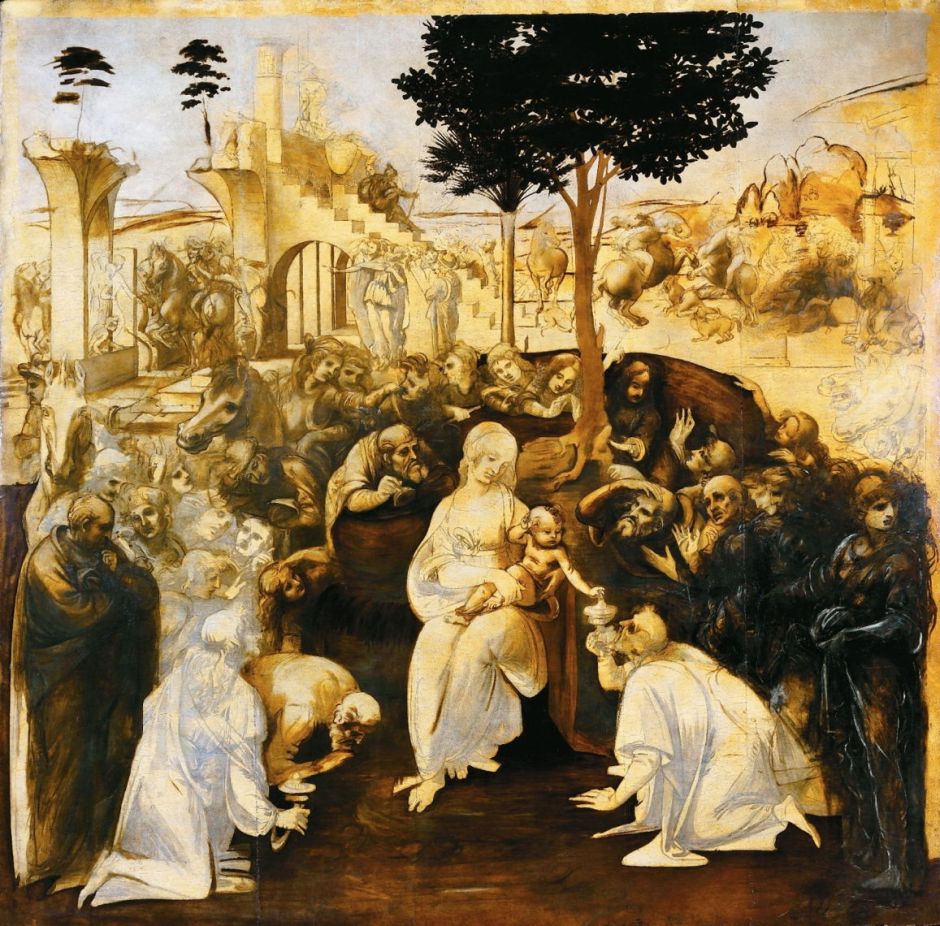To celebrate Boxing Day, I have a selection of my favourite paintings showing the Adoration of the Shepherds, although I start with a sadly abandoned Adoration, this time of the Magi.
Following the Nativity, there are three conventional religious scenes which have been popular in European religious painting. The Adoration of the Magi shows the three kings paying their respects to the infant Christ, and presenting him with their tributes of gold, frankincense and myrrh. The shepherds are first summoned by an angel who appears to them as they tend their flocks, in the Annunciation to the Shepherds, then they attend the Holy Family in their Adoration, which is based solely on the account in the Gospel of Luke, Chapter 2.

My first painting is one that sadly got away, Leonardo da Vinci’s Adoration of the Magi which he started in or soon after 1480. At nearly 2.5 metres in each dimension, it was one of his largest and most ambitious works to date, but probably had to be abandoned when he left Florence in 1482. It’s notable for the geometric arrangement of its four key figures, which seems to have stuck in the artist’s mind for two of his most famous paintings.

Just a few years after Leonardo had abandoned that, the master who is reputed to have taught Michelangelo, Domenico Ghirlandaio, painted this Adoration of the Shepherds (1485) for the church of Santa Trinita in Florence. The faces of his shepherds are here starting to come to life, and appear to have been painted from models.

Giorgione’s Adoration of the Shepherds or the Allendale Nativity was painted in 1505-10, and shows a cave housing the Holy Family rather than the more literal and conventional stable. The shepherds are even more faithful to life, with holes in their clothes and frayed sleeves, in unusual social realism for this time.

Jacopo Tintoretto’s The Adoration of the Shepherds from about 1578-81 opens his magnificent series depicting the life of Christ in the Sala superiore of the Scuola Grande di San Rocco in Venice.
He takes the conventional scene of the nativity and adds a second story. Within this, his references stay with tradition: downstairs is an ox and an ass, a cockerel, even a peacock. The Holy family are naturally upstairs, where the infant Christ really does look like a tiny, newborn infant. At the very top, peering through the tumbledown roof, are angels. There are visual links to the crucifixion in the ladder at the foot and cruciforms in beams of the roof.

Murillo’s Adoration of the Shepherds from about 1650 features delightful additional details including the old woman carrying a basketful of eggs, chickens in front of the kneeling shepherd, and that shepherd’s worn appearance. His composition brings the heads of the key figures together, where the strongest light is cast on the baby and his mother.

Charles Le Brun’s late painting of The Adoration of the Shepherds from 1689 is remarkable not just for its marvellous luminosity, but for the sheer number and presence of shepherd’s crooks. I can see five, which must be a record for this popular motif.

I make an exception here for Jules Bastien-Lepage’s outstanding painting of The Annunciation to the Shepherds (1875), which might have served as his painted manifesto, showing how he built on tradition rather than discarding it.
It strikes compromise between the gilding and Renaissance appearance of the angel, the rural realism of the shepherds who have come from Millet rather than Bethlehem, and the wonderfully controlled looseness and gesture of the darkened landscape. He wastes not a brushstroke in telling its simple story, in the almost averted facial expressions, the arms frozen in surprise, hands which have just been tending sheep, even their bare and filthy feet.
Later in the nineteenth century, this motif underwent modernisation as well.

Albin Egger-Lienz’s Christmas Eve from 1903 is a re-interpretation of the traditional adoration of the shepherds, apparently set in a Tyrolean cowshed, with skilful use of light.

My last painting is one that I have recently discovered in my series on British Impressionists. In the early twentieth century, Edward Stott painted a few religious motifs, including this undated pastel nocturne of the Adoration of the Shepherds.

